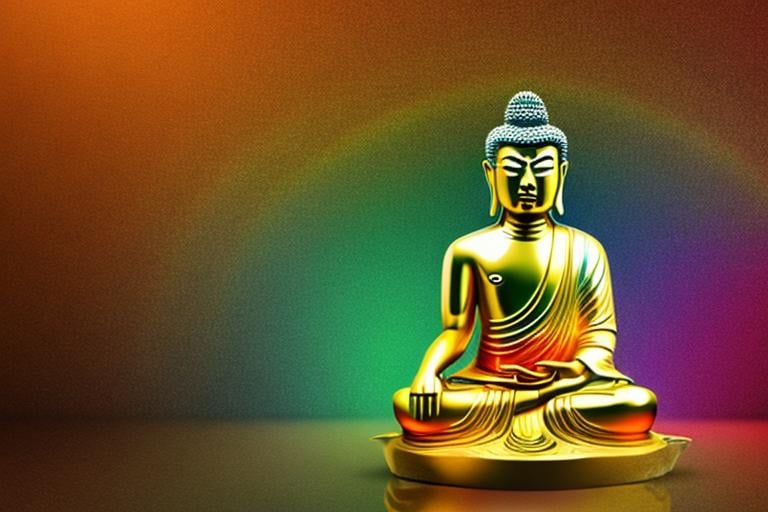
Buddhism has given rise to some of the most beautiful art and depictions of perhaps any spiritual tradition, and it’s for good reason. As one opinion piece by a researcher for Virginia Commonwealth University highlights, there is a strong scriptural and spoken tradition of color in Buddhism. This, in turn, has gone on to influence the study of Buddhism, the worship of its figures, and the philosophical tradition of it through history. Looking at where this adoration for color comes from is fairly straightforward, given the primacy of color in scripture and teachings – including the Buddha himself.
By Karoline Gore
Contributing Writer
The significance of blue
The color blue comes up a lot in day-to-day life. It’s the apparent color of the sea or sky; it’s valued in rare gems and precious stones, including sapphire and lapis. The flames that provide sustenance through cooking are blue, and 10% of people worldwide have blue eye color and see that color every day through the mirror. That note – of the eyes – is particularly important in Buddhism.
The ‘eye’ is an important aspect of Buddhist tradition. It’s not confined to the physical eye. As Dr Shen, founder of the Buddhist Association of the United States outlined at a celebration of the birthday of Buddha Shakyamuni, the human physical eye is only as important as the rest of the five – Heavenly, Dharma, Buddha and Dharma. Yet, the physical aspects of the Buddha play host to a specific connection to that blue. According to the Dhamma wheel, the inferred physical proportions of the Buddha note a departure from the widely-held brown eyes of the region, associating the color blue with his image. In terms of symbolism, the color blue signifies healing, and is a key part of the Lapis Medicine Master Buddha; in the sutras, Shakyamuni speaks “Whose sky-colored, holy body of lapis lazuli”.
Editors Note: Writer Karoline Gore writes this from the point of view of Buddhism generally. There is extensive color symbolism specific to Tibetan Buddhism, which we’ve covered in features on the five colors and the Five Dhyani Buddhas. For a feature on the Five Buddhas, see>>
The embrace of green
Green is another powerful color in Buddhism. Jade is known as a protective material in the tradition of the spiritual practice, and is closely associated with Amoghasiddhi, according to TibetVista. This buddha is said to personify fearlessness, according to Samye Institute, and Orgyen Chokgyur Lingpa recorded a prayer to be said in support of him; “In the northern pure realm of Fulfilled Activity, within the all-accomplishing palace of immaculate jealousy, Buddha Amoghasiddhi: to you I pray! Bless me that I may realize the utter purity of jealousy!”. Green is about fearlessness and accomplishment, but balance, too, and peace. It imparts a sense of protection, and confidence, and is closely associated with these factors in the paintings and sculptures made in its tones. It fights jealousy, and turns it into accomplishment.
Red and yellow
Two of the most iconic colors in Buddhism are red and yellow and their in-between, orange. Well noted for the color they provide to the ascetic robes of Buddhist monks, they have a distinct spiritual source that actually taps into two areas of principle. ChinaCulture.org explains more.
Red is the color of blood, and of bravery, too. In Tibetan Buddhism, religious infrastructure is painted red to reflect that. Yellow, meanwhile, is a symbol of humility, and a departure from hubris. Together, they create a symbol of resilience; bravery paired together with humility. The Buddha Amitabha is a patron of red; Buddha Ratnasambhava yellow. According to the Tibetan Buddhist Encyclopedia, the Earth Store Bodhisattva references the Buddha Ratnasambhava; “Again in the past, immeasurable, incalculable kalpas ago, as many as the grains of sand in the Ganges River, there appeared in the world a Buddha bearing the title of Ratnasambhava Tathagata. Any man or woman, hearing the Buddha’s name and showing respect to him, will soon attain the stage of an Arhat.” It’s interesting how yellow appears here once again, subtly, in the grains of sand in the river.
There are countless other examples of how color imbues a deeper meaning to practices of the Buddhist faith. They come to symbolize different paths of human life, and what actions can be taken to ensure health and wellbeing in this world and the next. From the eyes of the Buddha to the sands of grain of the Ganges, there is an everliving connection.

